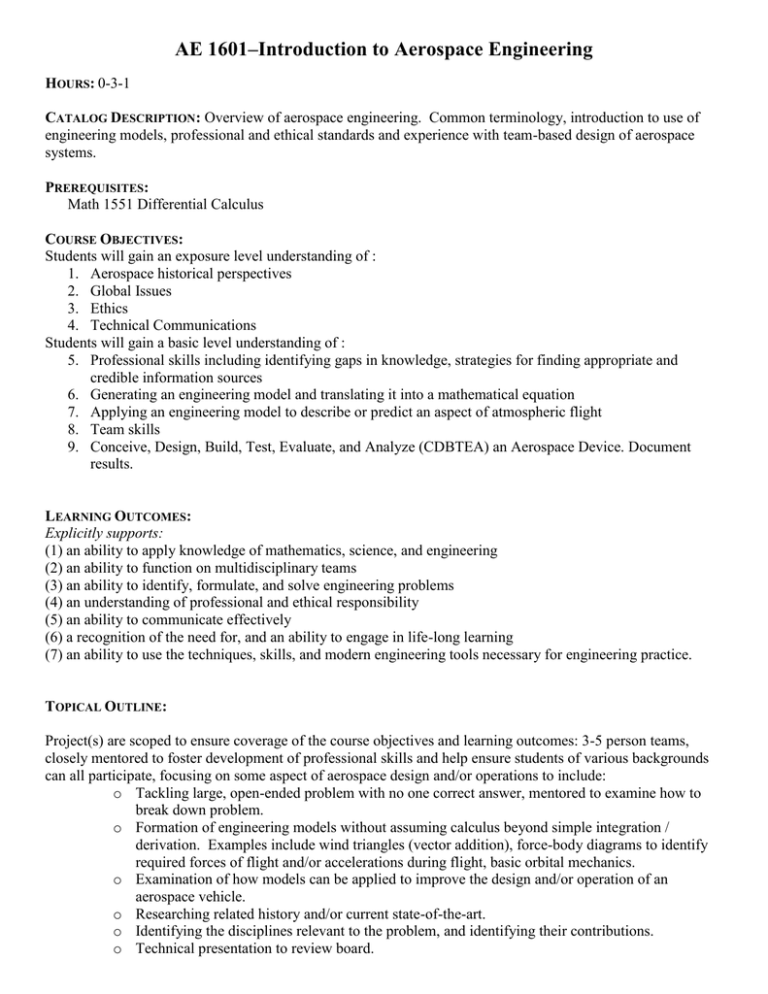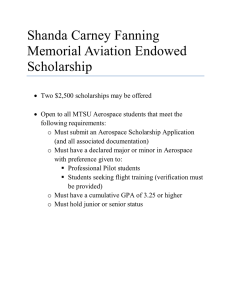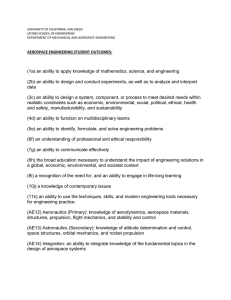AE 1601 SYLLABUS
advertisement

AE 1601–Introduction to Aerospace Engineering HOURS: 0-3-1 CATALOG DESCRIPTION: Overview of aerospace engineering. Common terminology, introduction to use of engineering models, professional and ethical standards and experience with team-based design of aerospace systems. PREREQUISITES: Math 1551 Differential Calculus COURSE OBJECTIVES: Students will gain an exposure level understanding of : 1. Aerospace historical perspectives 2. Global Issues 3. Ethics 4. Technical Communications Students will gain a basic level understanding of : 5. Professional skills including identifying gaps in knowledge, strategies for finding appropriate and credible information sources 6. Generating an engineering model and translating it into a mathematical equation 7. Applying an engineering model to describe or predict an aspect of atmospheric flight 8. Team skills 9. Conceive, Design, Build, Test, Evaluate, and Analyze (CDBTEA) an Aerospace Device. Document results. LEARNING OUTCOMES: Explicitly supports: (1) an ability to apply knowledge of mathematics, science, and engineering (2) an ability to function on multidisciplinary teams (3) an ability to identify, formulate, and solve engineering problems (4) an understanding of professional and ethical responsibility (5) an ability to communicate effectively (6) a recognition of the need for, and an ability to engage in life-long learning (7) an ability to use the techniques, skills, and modern engineering tools necessary for engineering practice. TOPICAL OUTLINE: Project(s) are scoped to ensure coverage of the course objectives and learning outcomes: 3-5 person teams, closely mentored to foster development of professional skills and help ensure students of various backgrounds can all participate, focusing on some aspect of aerospace design and/or operations to include: o Tackling large, open-ended problem with no one correct answer, mentored to examine how to break down problem. o Formation of engineering models without assuming calculus beyond simple integration / derivation. Examples include wind triangles (vector addition), force-body diagrams to identify required forces of flight and/or accelerations during flight, basic orbital mechanics. o Examination of how models can be applied to improve the design and/or operation of an aerospace vehicle. o Researching related history and/or current state-of-the-art. o Identifying the disciplines relevant to the problem, and identifying their contributions. o Technical presentation to review board. o Submission of a technical report. Preparatory lectures offered to support and supplement project(s) to ensure all topics in the course objectives are covered. Lectures during lab-times span the following topics: o Overview of disciplines in AE o Finding appropriate, credible information sources in aerospace engineering o Engineering problem solving, applying math and physics to predict flight o Ethics (e.g. Harvard Business School case study of the Challenger Incident) o Careers in aerospace with BSAE, MSAE and PhD, spanning range from research to design to operations.



